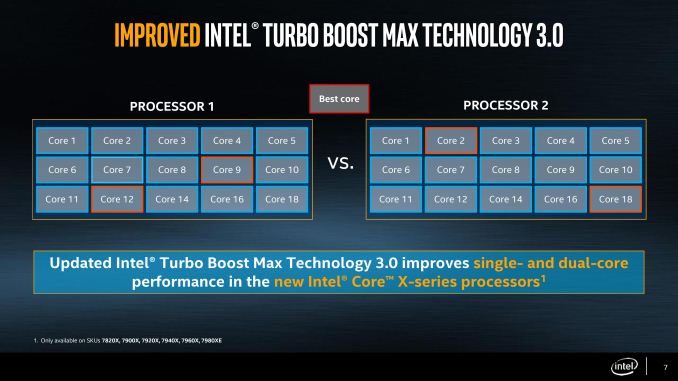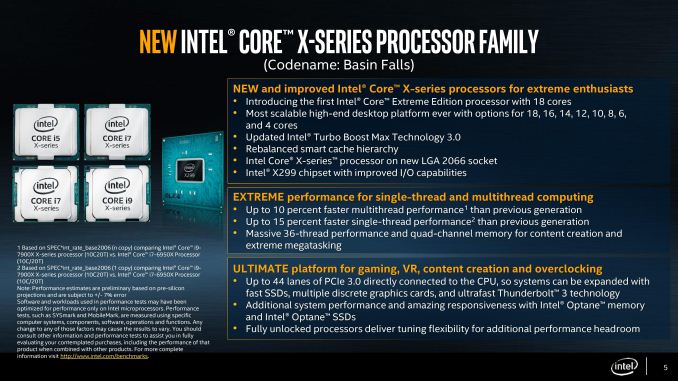Intel Announces Skylake-X: Bringing 18-Core HCC Silicon to Consumers for $1999
by Ian Cutress on May 30, 2017 3:03 AM ESTAnnouncement Four: AVX-512 & Favored Core
To complete the set, there are a couple of other points worth discussing. First up is that AVX-512 support coming to Skylake-X. Intel has implemented AVX-512 (or at least a variant of it) in the last generation of Xeon Phi processors, Knights Landing, but this will be the first implementation in a consumer/enterprise core.
Intel hasn’t given many details on AVX-512 yet, regarding whether there is one or two units per CPU, or if it is more granular and is per core. We expect it to be enabled on day one, although I have a suspicion there may be a BIOS flag that needs enabling in order to use it.
As with AVX and AVX2, the goal here is so provide a powerful set of hardware to solve vector calculations. The silicon that does this is dense, so sustained calculations run hot: we’ve seen processors that support AVX and AVX2 offer decreased operating frequencies when these instructions come along, and AVX-512 will be no different. Intel has not clarified at what frequency the AVX-512 instructions will run at, although if each core can support AVX-512 we suspect that the reduced frequency will only effect that core.
With the support of AVX-512, Intel is calling the Core i9-7980X ‘the first TeraFLOP CPU’. I’ve asked details as to how this figure is calculated (software, or theoretical), but it does make a milestone in processor design. We are muddying the waters a bit here though: an AVX unit does vector calculations, as does a GPU. We’re talking about parallel compute processes completed by dedicated hardware – the line between general purpose CPU and anything else is getting blurred.
Favored Core
For Broadwell-E, the last generation of Intel’s HEDT platform, we were introduced to the term ‘Favored Core’, which was given the title of Turbo Boost Max 3.0. The idea here is that each piece of silicon that comes off of the production line is different (which is then binned to match to a SKU), but within a piece of silicon the cores themselves will have different frequency and voltage characteristics. The one core that is determined to be the best is called the ‘Favored Core’, and when Intel’s Windows 10 driver and software were in place, single threaded workloads were moved to this favored core to run faster.
In theory, it was good – a step above the generic Turbo Boost 2.0 and offered an extra 100-200 MHz for single threaded applications. In practice, it was flawed: motherboard manufacturers didn’t support it, or they had it disabled in the BIOS by default. Users had to install the drivers and software as well – without the combination of all of these at work, the favored core feature didn’t work at all.
Intel is changing the feature for Skylake-X, with an upgrade and for ease-of-use. The driver and software are now part of Windows updates, so users will get them automatically (if you don’t want it, you have to disable it manually). With Skylake-X, instead of one core being the favored core, there are two cores in this family. As a result, two apps can be run at the higher frequency, or one app that needs two cores can participate.
Availability
Last but not least, let's talk about availability. Intel will likely announce availability during the keynote at Computex, which is going on at the same time as this news post goes live. The launch date should be sooner rather than later for the LCC parts, although the HCC parts are unknown. But no matter what, I think it's safe to say that by the end of this summer, we should expect a showdown over the best HEDT processor around.


















203 Comments
View All Comments
mdw9604 - Tuesday, May 30, 2017 - link
FYCK Intel. If AMD had not come out with Ryzen, they would still be sticking with 4 Core desktop processors and 8 cores on the HEDT machines and charging $1K plus for them. They are trying to make sure AMD can't compete. I'm buying AMD, I am not continuing to supporting Intel's monopolistic x86 stranglehold.Bullwinkle J Moose - Wednesday, May 31, 2017 - link
Preferred Core / Turbo 3 needs another update for the upcoming Cannon LakeEven if a single core could run @ 4.8Ghz single thread continuous while the second best core might reach 4.7 and another 4.6, why not let the core cool off while temporarily boosting the clocks "above" their "continuous" max speed on single threaded apps?
Cycle the cores to max "temporary" clock speed 5.2 / 5.1 / 5.0Ghz while the previous main core is cooling down
Turbo 4?
Ej24 - Wednesday, May 31, 2017 - link
It's worth noting that ryzen 7 is akin to lga115x. It's mainstream. Motherboards will cost half of what x299 will cost. There should be no comparisons made between am4 and lga2066. They're two different market segments. People keep making the comparison b/c core counts but it doesn't make sense. The Intel HEDT should be compared to Threadripper. Amd literally doubled our core count per dollar at the mainstream. Intel still hasn't.SanX - Wednesday, May 31, 2017 - link
Billion is very scary word for unwashed. For 100+ billion market cap company it is a change.Notmyusualid - Thursday, June 1, 2017 - link
@ SanXI feel like 'the unwashed' this morning, I better move my @ss...
:)
SanX - Wednesday, May 31, 2017 - link
I wrote this in respond to the two trolls who think that the cost of the fab is not included into the price of the chips./* Anandtech, fix your obsolete discussion forum which does not have Edit function and slips posts to the end from the threads if use Android Google browser with JS off.
close - Thursday, June 1, 2017 - link
Dude, you're the one who calculated that:"$2000 for 18 cores is $100 per core.
This is approximately 20x the production cost."
And concluded that:
"It is always good for monopoly to be a monopoly."
Don't be surprised that people take a p*ss at you for what you write. You are the one who suggested the relationship between the production price per core and the retail price is somehow relevant. Why not "per transistor"? Or "per mm^2"?
You chose an irrelevant metric (price/core when the CPU has additional components that you ignored), you ignored that there re many objective factors that make such a CPU more expensive (like yields which are worse the bigger the chip), you assumed everything is linear and can be quickly presented as a simple napkin calculation, and you tried to sell it. This isn't how any of this works so now it's easy to question your understanding on these topics. Maybe you're too washed...
tamalero - Wednesday, May 31, 2017 - link
140W TDP? jesus...Hrel - Wednesday, May 31, 2017 - link
I can't believe they released to consumers at all, what consumer pay $2000 for a CPU? Who is this for?Hell, I had a hard time getting a fortune 10 company to agree to pay more than $1000/CPU for the servers that ran their own network and directory.
I truly cannot imagine any consumer spending that much on a CPU. This baffles my mind.
Someone hit me up when Anandtech does a review of 200-$300 CPU's, as anything beyond that better be for a fucking server.
Morawka - Wednesday, May 31, 2017 - link
dude you dont know how many rich kids and benchmarkers there are in the world. As Ian noted, the top end Extreme Edition is always the best selling CPU out of all of them.. That was even true for Broadwell's 10c $1750 CPU last year.